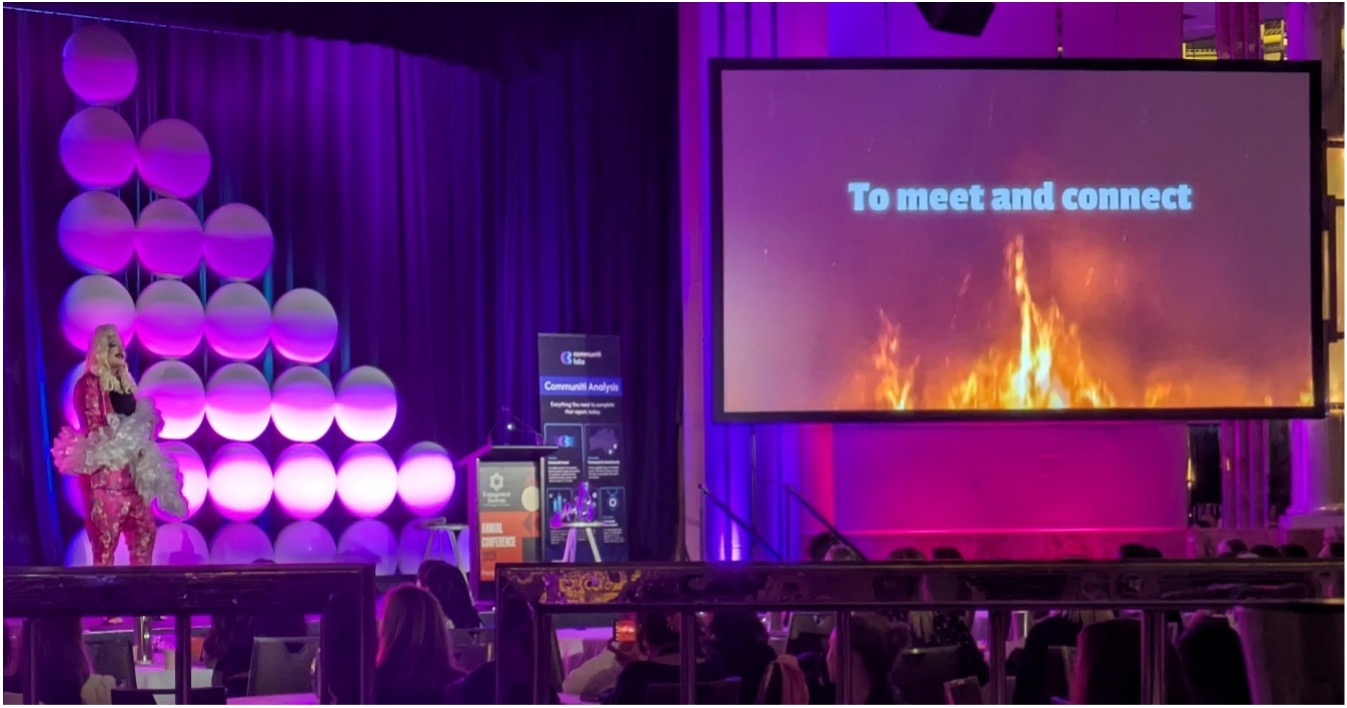In October 2025, The Engagement Institute (formerly IAP2) hosted its two-day annual conference. It featured candid discussions about the thrills and spills of engagement as well as a drag performance about engagement (read on for more details!).
Georgia Marett, our Senior Research and Behavioural Insights consultant, was there to soak it all up.
Engagement through the eyes of a researcher
The line between research and engagement can be a little blurry at times, but they are separate disciplines with their own norms, identities, and hangups (and conferences).
At the Government and Social Research Conference in April, two of TSD’s directors (Mel and Kate) spoke on exactly this dynamic – how research and engagement differ and how they can complement each other.
As a ‘research person’ suddenly spending two days in the world of engagement, Georgia had the following reflections.
- Engagement people are ‘people’ people. During the conference it was right to assume that anyone you met was up for a chat and people had to be asked multiple times to stop breaking the ice with their fellow conference-goers so the MC could carry on with proceedings!
- Research and engagement are both concerned with being seen as a ‘nice to have’ and not being listened to or valued by senior leadership. Both fields probably go about solving this in similar ways (showing leadership the value of their work and asking them to ‘spend money to save money’). However, it feels like engagement may be having a tougher time of it, even though it is sometimes required by legislation.
- Hard numbers might cut through a sea of qualitative reflections. In the debate about whether engagement should get out of the way so that housing projects can progress more quickly the shocking winner was the affirmative team! This team argued (with statistics) that engagement around housing is generally not representative of the current or future population of an area and achieves compromises that benefit nobody, while people remain without homes. The numbers they used really seemed to sway the audience of hardened engagement professionals.
- Dealing with ‘difficult’ participants happens in engagement sessions and research focus groups. Understanding the causes of people’s anger, bringing the temperature down, and channelling the energy into something more productive are universal skills when you are talking to members of the public. Based on the stories from the conference, though, engagement may take the cake in terms of number of peeved people per project.
- Burnout is a thing and engagement professionals need to take care of themselves and recognise when they are giving too much to an engagement process and should step back. Employers must support their frontline engagement specialists who bear the brunt of community anger and distrust.
Next year it would be great to see more about how research and engagement can combine forces to empower communities and inform leaders and policy makers.
Is there more to engagement than infrastructure?

Looking at the conference program, you could be forgiven for thinking that engagement is something that only happens on infrastructure projects. There were sessions about community benefits of projects, engagement across the lifecycle of an infrastructure project, and the aforementioned debate about engagement during housing projects. Aside from the sessions, most of the people at the conference worked on infrastructure projects and most examples were infrastructure related.
A lot of excellent engagement happens around infrastructure projects. It is clear that the infrastructure sector generates a lot of the demand for engagement services. However, it would be good to talk about the challenges of non-infrastructure engagements.
- How do you engage people who don’t have to be part of an engagement because they live where a project is happening?
- How do you talk to people about complex policy changes that might affect them?
- How do you engage people who may have had traumatic experiences or need support to engage?
For next time, it would be great to see more of a focus on non-infrastructure engagement so that these topics can be explored.
Engagement drag show – now I’ve seen it all!

In the conference (as in this blog post) the most exciting part was left until last – Isabelle GiaVulva, engagement specialist extraordinaire! Isabella took us through her experience working in engagement for Greyvale City Council on their proposed off-leash dog park.
Dealing with her hands-off boss Richard, running everything through MarComms, and presenting to a fractious group of councillors – the show had it all.
Songs like ‘Make Your Pop-ups POP’ were certified bangers and the interpretive dance about being ‘off leash’ had to be seen to be believed.
The performance took a turn for the emotional towards the end. Isabella experienced something that many engagement professionals can relate to – angry citizens who blame the engagement professional for the perceived failings of a project or the system.
She got real about how engagement can affect the engager. She left us with a message about bringing kindness into engagement and remembering that the engagement specialists reaching out into the community are real people too.
The Engagement Institute’s conference in 2025 was a great opportunity to learn about best-practice and innovative engagement techniques and connect with engagement professionals.
See you in Brisbane next year!


.png)







